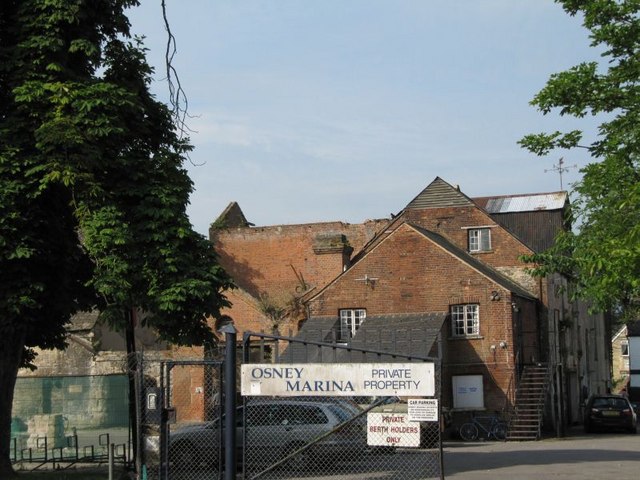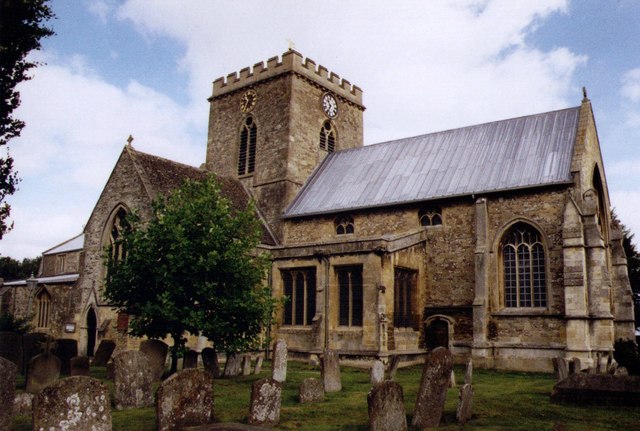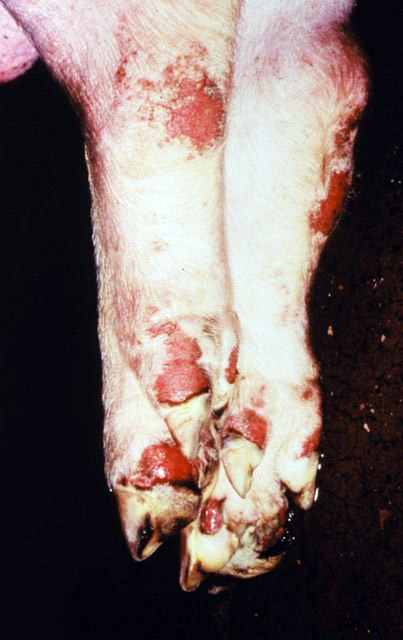|
Osney Mill
Osney Mill is a former flour mill on a branch of the River Thames in Oxford, England, located south of the Botley Road, down Mill Street. While the mill was gutted by a fire in 1945 and remained derelict for over 60 years, the exterior walls were incorporated into a modern apartment building during the early-2010s that now occupies the site. Close by the site of the mill is Osney Lock. To the east is Osney Cemetery, to the west is Osney Island, while Oxford railway station lies just to the north. History The mill is on the site of the now-destroyed Osney Abbey. Little is left of the abbey, but there is still a rubble and timber-framed structure at the mill site, which may date from the 15th century. The remnants were Grade II listed in 1954. In 1895, William Henry Munsey came to Oxford after his farming business in Cambridgeshire was affected by foot and mouth disease. Initially, he worked for Pratt & Haines as a forage manager. In 1898, he went into partnership with Archer ... [...More Info...] [...Related Items...] OR: [Wikipedia] [Google] [Baidu] |
Osney Marina - Geograph
Osney or Osney Island (; an earlier spelling of the name is ''Oseney'') is a riverside community in the west of the city of Oxford, England. In modern times the name is applied to a community also known as Osney Town astride Botley Road, just west of the city's main Oxford railway station, railway station, on an island surrounded by the River Thames, Osney Ditch and another backwater connecting the Thames to Osney Ditch. Until the early 20th century the name was applied to the larger island of Oxford Castle and New Osney (between Castle Mill Stream and the main stream of the Thames) on which Osney Abbey and Osney Mill were established during the Middle Ages. The place plays a minor but significant role in ''The Miller's Tale'' in Chaucer's ''The Canterbury Tales''. History The name "Osney" is Old English, and means either "Osa's Island" or "island in the Ouse": Ouzen Ait is a elision, base form and Ouse is an Old English word for a (large) river. Until the early twentieth cen ... [...More Info...] [...Related Items...] OR: [Wikipedia] [Google] [Baidu] |
Osney Abbey
Osney Abbey or Oseney Abbey, later Osney Cathedral, was a house of Augustinian canons at Osney in Oxfordshire. The site is south of the modern Botley Road, down Mill Street by Osney Cemetery, next to the railway line just south of Oxford station. It was founded as a priory in 1129, becoming an abbey around 1154. It was dissolved in 1539 but was created a cathedral, the last abbot Robert King becoming the first Bishop of Oxford. The see was transferred to the new foundation of Christ Church in 1545 and the building fell into ruin. It was one of the four renowned monastic houses of medieval Oxford, along with St Frideswide's Priory, Rewley and Godstow. History The house was founded by Robert D'Oyly the younger, Norman governor of Oxford, prompted by his wife, Edith Forne, who, to expiate the sins of her former life as the mistress of Henry I, solicited her husband to this pious work with a story of the chattering of magpies, interpreted by a chaplain as souls in Purgator ... [...More Info...] [...Related Items...] OR: [Wikipedia] [Google] [Baidu] |
Oxford Mail
''Oxford Mail'' is a daily tabloid newspaper in Oxford, England, owned by Newsquest. It is published six days a week. It is a sister paper to the weekly tabloid ''The Oxford Times''. History The ''Oxford Mail'' was founded in 1928 as a successor to ''Jackson's Oxford Journal''. From 1961 until 1979 its editor was Mark Barrington-Ward. At that time it was owned by the Westminster Press, and was an evening newspaper. The ''Oxford Mail'' is now published in the morning. In the second half of 2008 its circulation fell to 23,402, by 2013 it had fallen to 16,569, a year-on-year decline of 5.6% By the second half of 2014, its circulation had fallen to 12,103. In the period July to December 2015, the paper's circulation fell again, to 11,173. In January to June 2016, a further decline to 10,777 was recorded, an 8.4% fall in year-on-year. The latest published circulation was 6,015 (July - December 2021). Notable former staff * Morley Safer * Sir David Bell David Bell may refer to: ... [...More Info...] [...Related Items...] OR: [Wikipedia] [Google] [Baidu] |
Oxford City Council
Oxford City Council is the lower-tier local government authority for the city of Oxford in England, providing such services as leisure centres and parking. Social Services, Education and Highways services (amongst others) are provided by Oxfordshire County Council. Overview Between the 2004 local elections, and 2010 the council was in minority administration, first by councillors from the Labour Party, with the Liberal Democrats being the official opposition. In 2006 these roles were reversed, although two years later the council returned to being run by a minority Labour administration.Election 2008: Oxford council , 2008 before they took full control in 2010. Despite the ... [...More Info...] [...Related Items...] OR: [Wikipedia] [Google] [Baidu] |
Wantage
Wantage () is a historic market town and civil parish in Oxfordshire, England. Although within the boundaries of the historic county of Berkshire, it has been administered as part of the Vale of White Horse district of Oxfordshire since 1974. The town is on Letcombe Brook, south-west of Abingdon, north-west of Reading, south-west of Oxford and north-west of Newbury. It was the birthplace of King Alfred the Great in 849. History Wantage was a small Roman settlement but the origin of the toponym is somewhat uncertain. It is generally thought to be from an Old English phrase meaning "decreasing river". King Alfred the Great was born at the royal palace there in the 9th century, in what was originally known as Wanating. Wantage appears in the Domesday Book of 1086. Its value was £61 and it was in the king's ownership until Richard I passed it to the Earl of Albemarle in 1190. Weekly trading rights were first granted to the town by Henry III in 1246. Markets are now held ... [...More Info...] [...Related Items...] OR: [Wikipedia] [Google] [Baidu] |
Bread
Bread is a staple food prepared from a dough of flour (usually wheat) and water, usually by baking. Throughout recorded history and around the world, it has been an important part of many cultures' diet. It is one of the oldest human-made foods, having been of significance since the dawn of agriculture, and plays an essential role in both religious rituals and secular culture. Bread may be leavened by naturally occurring microbes (e.g. sourdough), chemicals (e.g. baking soda), industrially produced yeast, or high-pressure aeration, which creates the gas bubbles that fluff up bread. In many countries, commercial bread often contains additives to improve flavor, texture, color, shelf life, nutrition, and ease of production. History Bread is one of the oldest prepared foods. Evidence from 30,000 years ago in Europe and Australia revealed starch residue on rocks used for pounding plants. It is possible that during this time, starch extract from the roots of plants, such as c ... [...More Info...] [...Related Items...] OR: [Wikipedia] [Google] [Baidu] |
Flour
Flour is a powder made by grinding raw grains, roots, beans, nuts, or seeds. Flours are used to make many different foods. Cereal flour, particularly wheat flour, is the main ingredient of bread, which is a staple food for many cultures. Corn flour has been important in Mesoamerican cuisine since ancient times and remains a staple in the Americas. Rye flour is a constituent of bread in central and northern Europe. Cereal flour consists either of the endosperm, germ, and bran together (whole-grain flour) or of the endosperm alone (refined flour). ''Meal'' is either differentiable from flour as having slightly coarser particle size (degree of comminution) or is synonymous with flour; the word is used both ways. For example, the word '' cornmeal'' often connotes a grittier texture whereas corn flour connotes fine powder, although there is no codified dividing line. The CDC has cautioned not to eat raw flour doughs or batters. Raw flour can contain bacteria like '' E. col ... [...More Info...] [...Related Items...] OR: [Wikipedia] [Google] [Baidu] |
Foot And Mouth
Foot-and-mouth disease (FMD) or hoof-and-mouth disease (HMD) is an infectious and sometimes fatal viral disease that affects cloven-hoofed animals, including domestic and wild bovids. The virus causes a high fever lasting two to six days, followed by blisters inside the mouth and near the hoof that may rupture and cause lameness. FMD has very severe implications for animal farming, since it is highly infectious and can be spread by infected animals comparatively easily through contact with contaminated farming equipment, vehicles, clothing, and feed, and by domestic and wild predators. Its containment demands considerable efforts in vaccination, strict monitoring, trade restrictions, quarantines, and the culling of both infected and healthy (uninfected) animals. Susceptible animals include cattle, water buffalo, sheep, goats, pigs, antelope, deer, and bison. It has also been known to infect hedgehogs and elephants; llamas and alpacas may develop mild symptoms, but are resistant t ... [...More Info...] [...Related Items...] OR: [Wikipedia] [Google] [Baidu] |
Cambridgeshire
Cambridgeshire (abbreviated Cambs.) is a Counties of England, county in the East of England, bordering Lincolnshire to the north, Norfolk to the north-east, Suffolk to the east, Essex and Hertfordshire to the south, and Bedfordshire and Northamptonshire to the west. The city of Cambridge is the county town. Following the Local Government Act 1972 restructuring, modern Cambridgeshire was formed in 1974 through the amalgamation of two administrative counties: Cambridgeshire and Isle of Ely, comprising the Historic counties of England, historic county of Cambridgeshire (including the Isle of Ely); and Huntingdon and Peterborough, comprising the historic county of Huntingdonshire and the Soke of Peterborough, historically part of Northamptonshire. Cambridgeshire contains most of the region known as Silicon Fen. The county is now divided between Cambridgeshire County Council and Peterborough City Council, which since 1998 has formed a separate Unitary authorities of England, unita ... [...More Info...] [...Related Items...] OR: [Wikipedia] [Google] [Baidu] |
Grade II Listed
In the United Kingdom, a listed building or listed structure is one that has been placed on one of the four statutory lists maintained by Historic England in England, Historic Environment Scotland in Scotland, in Wales, and the Northern Ireland Environment Agency in Northern Ireland. The term has also been used in the Republic of Ireland, where buildings are protected under the Planning and Development Act 2000. The statutory term in Ireland is " protected structure". A listed building may not be demolished, extended, or altered without special permission from the local planning authority, which typically consults the relevant central government agency, particularly for significant alterations to the more notable listed buildings. In England and Wales, a national amenity society must be notified of any work to a listed building which involves any element of demolition. Exemption from secular listed building control is provided for some buildings in current use for worship, ... [...More Info...] [...Related Items...] OR: [Wikipedia] [Google] [Baidu] |
Oxford Railway Station
Oxford railway station is a mainline railway station, one of two serving the city of Oxford, England. It is about west of the city centre, north-west of Frideswide Square and the eastern end of Botley Road. It is on the line for trains between and Hereford via . It is a starting point for fast and local trains to London Paddington and , and for local trains to , Worcester (Shrub Hill and Foregate stations), and . It is also on the north/south Cross Country Route from and via and Reading to and . The station is managed by Great Western Railway, and also served by CrossCountry and Chiltern Railways trains. Immediately to the north is Sheepwash Channel Railway Bridge over the Sheepwash Channel. History The Great Western Railway (GWR) opened to Oxford on 12 June 1844 with a terminus station in what is now Western Road, Grandpont. In 1845 the Oxford and Rugby Railway (ORR) began to build its line, starting from a junction at New Hinksey south of the GWR terminus. The juncti ... [...More Info...] [...Related Items...] OR: [Wikipedia] [Google] [Baidu] |







.jpg)